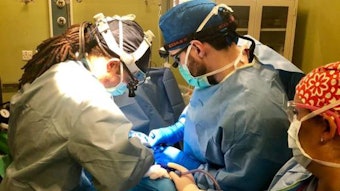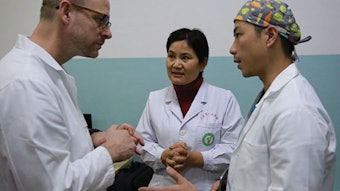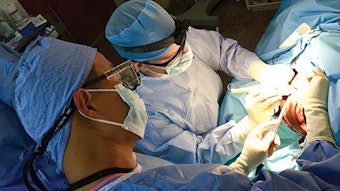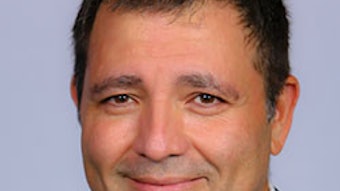When the going gets tough, the tough get going
PRACTICE PROFILE Sady Selaimen da Costa, MD, MSc, Phd, currently serves as Chair of the American Academy of Otolaryngology–Head and Neck Surgery Foundation (AAO-HNSF) International Advisory Board (IAB). He took time out of his schedule to share his global perspective and diverse experience in practice and leadership with the Bulletin.
PRACTICE PROFILE
Sady Selaimen da Costa, MD, MSc, Phd, currently serves as Chair of the American Academy of Otolaryngology–Head and Neck Surgery Foundation (AAO-HNSF) International Advisory Board (IAB). He took time out of his schedule to share his global perspective and diverse experience in practice and leadership with the Bulletin.
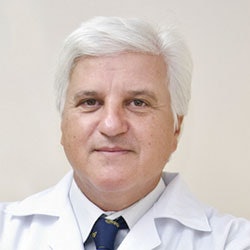 Sady Selaimen da Costa, MD, MSc, PhD
Sady Selaimen da Costa, MD, MSc, PhDIn addition to being the Clinical Professor and Chair of the Department of Otolaryngology, Head and Neck Surgery at the University of Rio Grande do Sul in Brazil, Dr. da Costa also practices part-time in his private office, which was founded in the early 1990s.
“This duality is very common here in Brazil, since our academic system is a little bit different from that in America. It is nice to be confronted on a daily basis with two distinct clinical sets and different social levels,” said Dr. da Costa, who practices otology and neurotology 100 percent of his time, seeing 50 to 60 patients every week. Most of Dr. da Costa’s patients come from the southernmost part of Brazil, with a few from other regions or neighboring countries such as Uruguay.
The path to medicine for Dr. da Costa was paved by the hard work of his parents. Neither were college educated, but they worked to fulfill an “immigrant’s big dream” of sending their children to school to become doctors. His oldest brother is a dentist, followed by his other brother, who is a cardiologist, and his sister is a lawyer. As the fourth child, born in Porto Alegre, Brazil, Dr. da Costa, after much deliberation between medicine and engineering, said he decided for “the noblest of all sciences: medicine.”
Once he selected his path to medicine, otolaryngology seemed like a natural selection. “In my opinion, objectivity is one of the hallmarks our specialty. I literally fell in love with ENT from the very beginning when I realized that it is a fantastic medical field. Besides being very straightforward, it allows the physician to exercise medicine in its essence and plenitude as an astute clinician, delicate microsurgeon, and radical surgeon,” said Dr. da Costa.
He completed his residency at the university hospital in Porto Alegre, but during the last year of the program he was faced with decisions for next steps. It was at this time that he decided to specialize in otology and neurotology. The other decision was a much more complex goal to achieve. “I wished to join the Academy, and if possible, my native university.” To realize this dream, Dr. da Costa knew a fellowship outside the borders of Brazil would be mandatory.
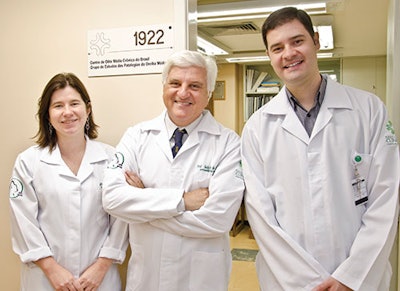 Dr. Leticia Schmidt Rosito and Dr. Mauricio Noschang flank Dr. da Costa
Dr. Leticia Schmidt Rosito and Dr. Mauricio Noschang flank Dr. da Costa“This was not a simple task since I had no money or networking connections. And this was a time without internet, Google, or social media. I had only the ‘snail mail’ to depend on—different times indeed,” said Dr. da Costa.
After much perseverance, he was awarded a Rotary Foundation scholarship and granted a fellowship in Minneapolis, MN, under the supervision of Michael M. Paparella, MD. “It is hard, if not impossible, to stress the importance of Dr. Paparella in my life. I prematurely lost my father while in the U.S., and Dr. Paparella became, literally, my second father.”
After two years in the U.S., Dr. da Costa then attended the University of São Paulo, where he received his MSc in 1991 and PhD in 1995. “Finally, after almost seven years on the road, a position was opened in my own University of Rio Grande do Sul. Once again, I had to go through a very tough selection, but I joyfully got my dreamed position. End of the game? No, it was just the beginning,” said Dr. da Costa.
His career encapsulates a variety of factions beyond private practice, including international education, mission work, and research. “My academic life has been very prolific, and I travel around the world lecturing and participating in courses and seminars. Naturally, these frenetic activities demand a great deal of time with an impact on my practice. Still, I am lucky enough to work in fine harmony with a great team of colleagues (all of them former students), who take care of my practice whenever I am not available.”
This commitment to global education in otolaryngology is not without an economic impact. “What really moves me, my biggest professional thrill has always been, by far, to make a difference: the recognition of my colleagues and the satisfaction of my patients. “
His mission work is also another area of his dedicated focus on patients. He is a member of the Collegium Oto-Rhino-Laryngologicum Amicitiae Sacrum, the Fisch International Microsurgery Foundation in Switzerland, and the International Hearing Foundation in Minneapolis, MN. He also served as a volunteer in a charity medical mission in Senegal and collaborated on many educational projects in India.
“These wonderful experiences have created a network of connections with colleagues from all around the globe and consistently enhanced my understanding of the world and real life. I truly believe that every single step of this way has had its own importance, but as a whole, if they had not eventually translated into better patient care, then they were meaningless,” said Dr. da Costa.
Research is another important aspect of practice and patient care where Dr. da Costa demonstrates commitment and passion. “In my opinion, if you are in the Academy, doing research is not an option but a big and essential part of your job,” he said.
Dr. da Costa was first exposed to research as a fellow in Minneapolis, MN, in the late 1980s. He joined the Otitis Media Group which was headed by Dr. Paparella. Funded by a robust grant from the National Institute of Health, it included many researches from a variety of fields. “They were developing a pathogenesis model for otitis media named the ‘Theory of the Continuum,’ employing different animal models. At the same time, I was introduced to the fascinating world of the histopathology of the ear in the Otopathology Temporal Bone Lab, where I studied the microscopic profile of chronic otitis media. Those studies, later, were the basis and backbones for both my master and doctorate thesis.”
When he returned to Brazil, Dr. da Costa kept the fervor of research alive, even though he encountered many challenges to his quest for continued research, including lack of facilities and funding. “As a young and motivated researcher, my impetus did not fade away, and I looked for alternatives to continue my studies. While in America I learned two inspiring quotes, which, in my opinion, nicely summarize the American spirit: ‘The difficult, we do at once. The impossible, takes a little bit longer.’ and ‘When the going gets tough, the tough get going!’”
Dr. da Costa’s solution was the creation of the Brazilian Studies Center for Chronic Otitis Media (COM.Br), a combined effort of medical students, residents, staff, audiologists, biologists, visiting doctors, professors, and postgraduate students. “Due to the high prevalence of chronic otitis media in our country, I put together my own team, made some necessary investments out of my pocket, and got fully organized to record all pertaining clinical data since the patient number one.”
Today, COM.Br is one of the biggest centers in the world fully dedicated to studying every facet of otitis media, developing several lines of applied research, scientific papers, thesis, presentations, and book chapters. The success of the center drew attention from the Brazilian agencies for research, which recently decided to fund the newly created division for animal studies.
When posed the question about the specialty’s greatest opportunities and challenges ahead, Dr. da Costa reflected on the past to speak to the future. “It is really hard to predict. I am sure that our antecessors, the real pioneers of our specialty back in the days, would have never imagined the dimensions that modern otolaryngology achieved. Our current ability to collaborate with areas as distant as neurology, neurosurgery, genetics, and oncology is ‘infamous.’ In fact, contemporary otolaryngology emerged in the twenty-first century as a consolidated, recognized, and pluripotential science.”
“Our smashing victory in the treatment of deafness is the most emblematic. But there is a lot of work to be done to gain a better understanding of the biology and chemotherapy of tumors as well as robotic and endoscopic minimally invasive surgery to the skull base. Clinically we have a long way to go in the treatment of tinnitus, allergies, vestibular rehabilitation, and sleep disorders, just to mention a few. Yes, our challenges are enormous but not bigger than our ability to create good and innovative solutions. Our history has consistently shown that,” said Dr. da Costa.
These opportunities and challenges of the specialty and medicine in general are distinct areas of common ground for the specialty on an international level. In addition to serving as Chair of the IAB, and previously as Vice Chair, Dr. da Costa has held many leadership positions, such as Vice President and President of the Brazilian Otological Society, Director of Continuing Medical Education of the Brazilian Association of Otolaryngology (ABORL), and Vice President and President of the ABORL.
“It is well-known globally that the AAO-HNS has established itself as a standard of excellence in many aspects and has become an authentic benchmark for other medical societies. It is also unequivocal that its Annual Meeting is the global scientific climax of the specialty calendar, gathering thousands of colleagues from all over the world,” he said.
The IAB, which holds a General Assembly during the Annual Meeting and serves as a “voice” of international otolaryngologist-head and neck surgeons, was established in 2016 as an international member network within the AAO-HNSF. It is made up of global otolaryngology-head and neck surgery societies from the Academy’s International Corresponding Societies affiliated network.
“As an International Member, besides the Annual Meeting and continuing medical education through AcademyU®, if I could choose one of the best advantages of joining and participating in the AAO-HNS, I would definitely select the expansion of your personal network and global partnerships. Sharing and collaborating with other nations is the best and most honorable way of growing bigger and stronger to meet the needs of our global ENT patients,” said Dr. da Costa.
When asked about sharing his diverse, global perspective and experience with the Bulletin, Dr. da Costa responded, “This interview obliges you to take ‘time out’ and think about your choices, plans, accomplishments, victories, and losses—shedding lights into your past, contemplating your present, and planning your future. In short, gives you the chance of projecting a small movie of your life.”
Join Dr. da Costa at the AAO-HNSF 2019 Annual Meeting & OTO Experience in New Orleans, Lousiana, September 14-18, as he chairs at the IAB General Assembly.



